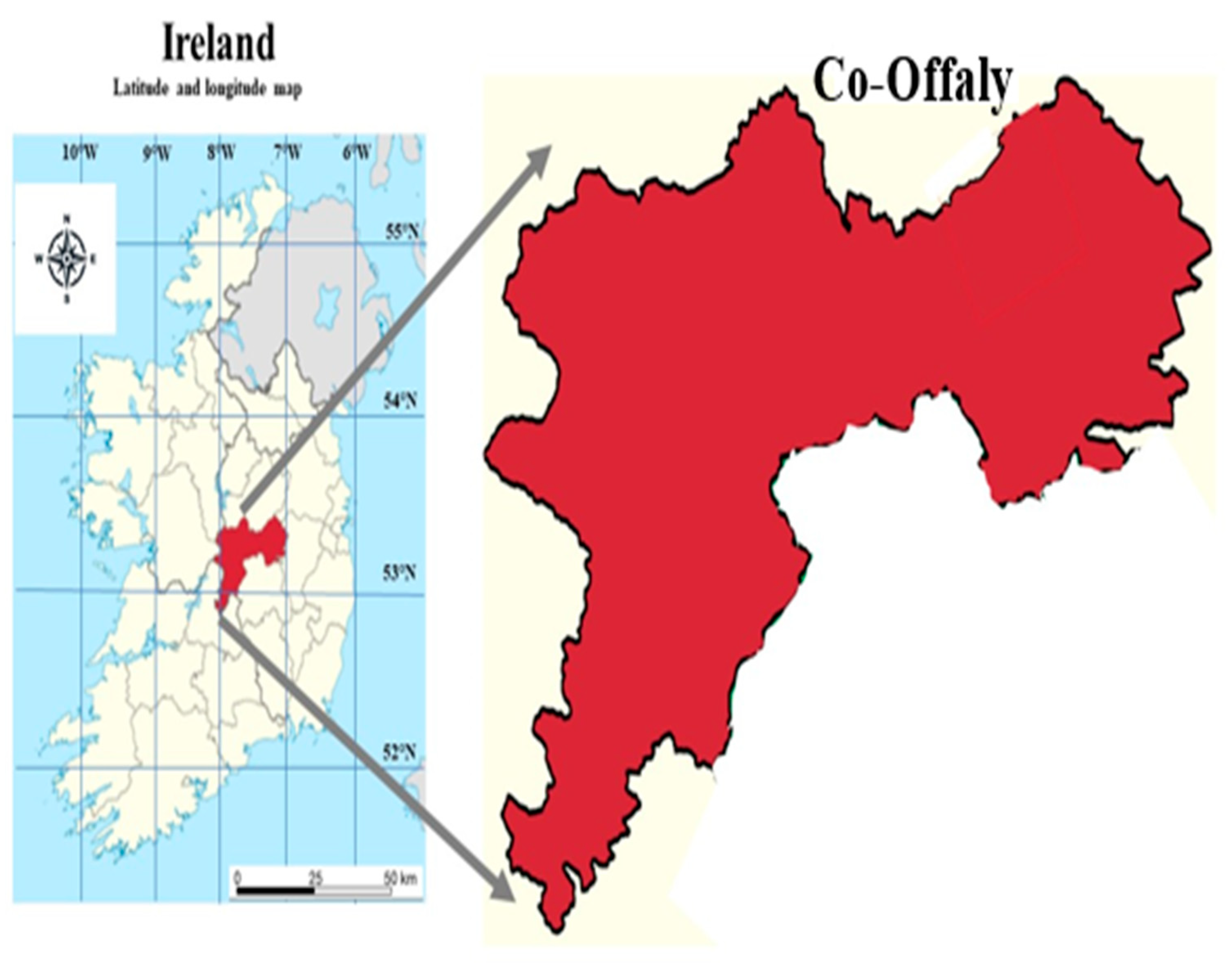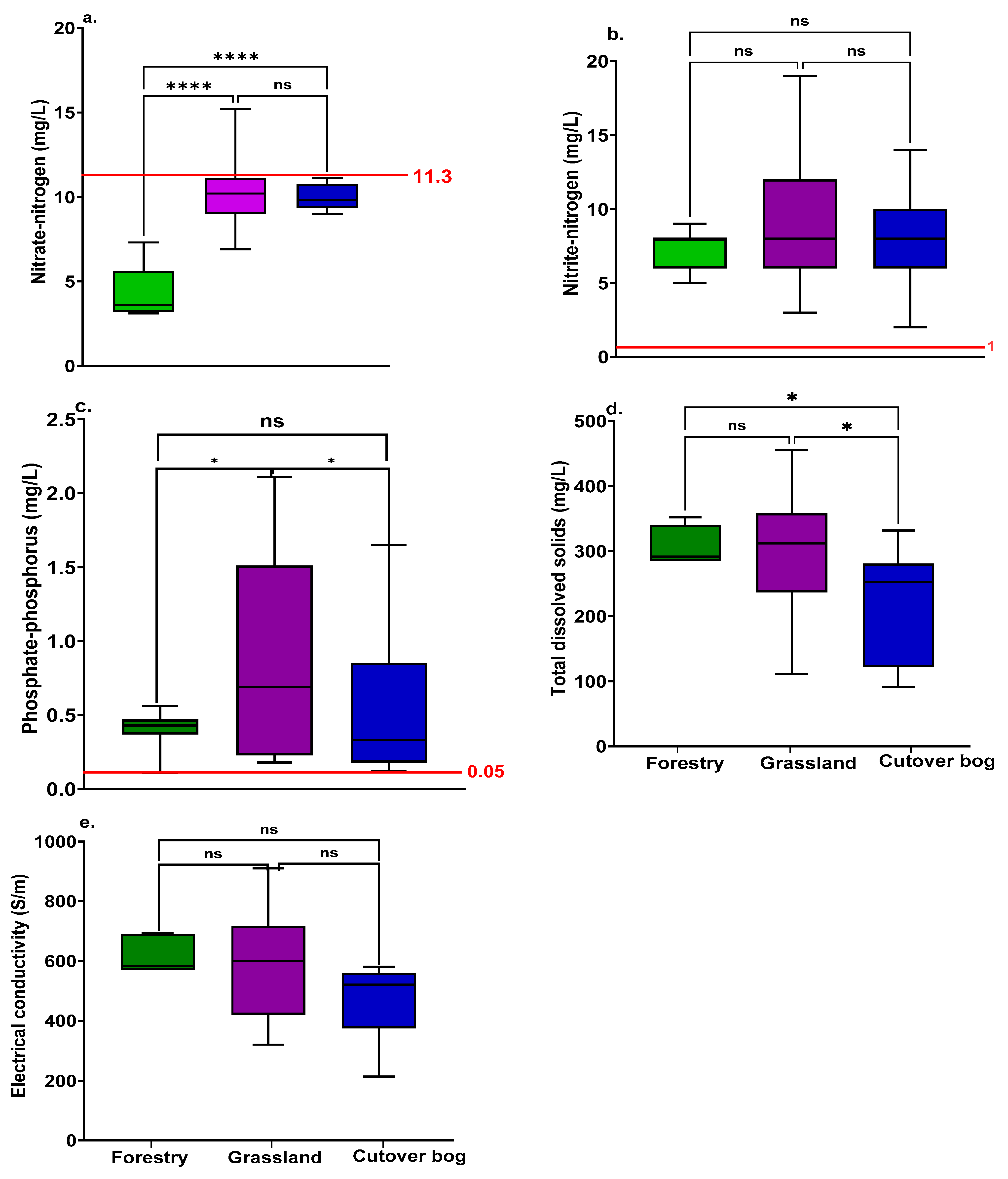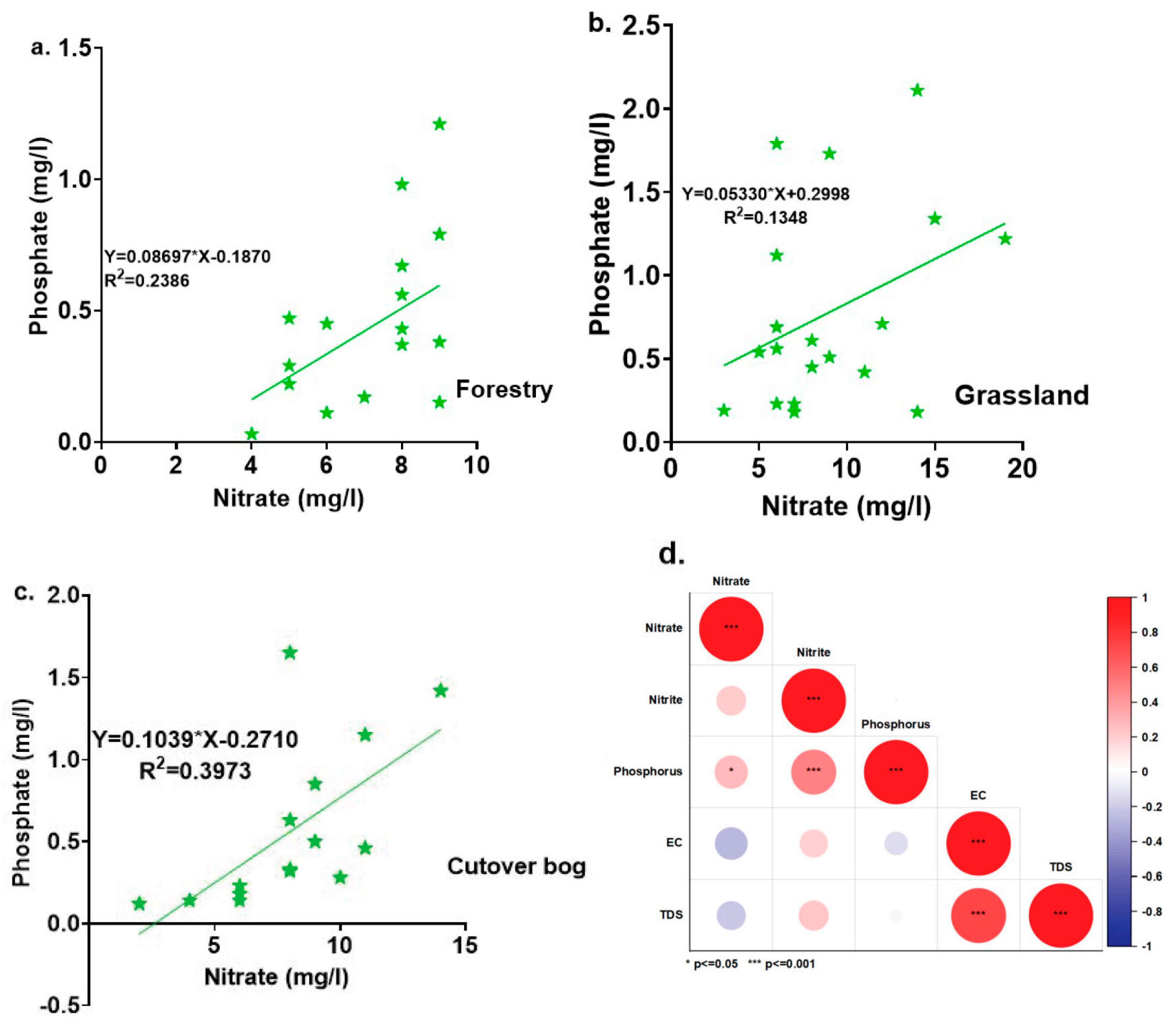Assessment of Nitrate and Phosphate Concentrations in Discharge Water from Ditch Networks across Different Peatland Use Types: Implications for Sustainable Peatland Use Management
Abstract
:1. Introduction
2. Materials and Methods
2.1. Study Area and Sample Collection
2.2. Water Analysis
2.3. Nutrient Pollution Index (NPI)
2.4. Data Analysis
3. Results and Discussion
3.1. Nutrient Concentration (Nitrite, Nitrate–Nitrogen, and Phosphate–Phosphorus), Electrical Conductivity, and Total Dissolved Solids of Discharge Water from Ditch Networks of Altered Peatlands Ecosystems
3.2. Nutrient Concentration (Nitrite–Nitrogen, Nitrate–Nitrogen, and Phosphate–Phosphorus), Electrical Conductivity and Total Dissolved Solids of Discharge Water from Ditch Networks under Different Peatland Use Types
3.3. Nutrient Pollution Index (NPI) of Discharge Water from Ditch Networks under Different Peatland Use
3.4. Correlation and Principal Component Analysis
3.5. Sustainable Management
4. Conclusions and Recommendations
Author Contributions
Funding
Institutional Review Board Statement
Informed Consent Statement
Data Availability Statement
Conflicts of Interest
References
- Apori, S.O.; Mcmillan, D.; Giltrap, M.; Tian, F. Mapping the Restoration of Degraded Peatland as a Research Area: A Scientometric Review. Front. Environ. Sci. 2022, 10, 942788. [Google Scholar] [CrossRef]
- Hergoualc’h, K.; Verchot, L.V. Greenhouse Gas Emission Factors for Land Use and Land-Use Change in Southeast Asian Peatlands. Mitig. Adapt. Strateg. Glob. Chang. 2014, 19, 789–807. [Google Scholar] [CrossRef]
- Limpens, J.; Berendse, F.; Blodau, C.; Canadell, J.G.; Freeman, C.; Holden, J.; Roulet, N.; Rydin, H.; Schaepman-Strub, G. Peatlands and the Carbon Cycle: From Local Processes to Global Implications—A Synthesis. Biogeosciences 2008, 5, 1475–1491. [Google Scholar] [CrossRef]
- Tarnocai, C.; Stolbovoy, V. Northern Peatlands: Their Characteristics, Development and Sensitivity to Climate Change. Dev. Earth Surf. Process. 2006, 9, 17–51. [Google Scholar]
- Holden, J.; Chapman, P.J.; Labadz, J.C. Artificial Drainage of Peatlands: Hydrological and Hydrochemical Process and Wetland Restoration. Prog. Phys. Geogr. 2004, 28, 95–123. [Google Scholar] [CrossRef]
- Kalisz, B.; Lachacz, A.; Glazewski, R. Effects of Peat Drainage on Labile Organic Carbon and Water Repellency in NE Poland. Turk. J. Agric. For. 2015, 39, 20–27. [Google Scholar] [CrossRef]
- Renou-Wilson, F.; Barry, C.; Müller, C.; Wilson, D. The Impacts of Drainage, Nutrient Status and Management Practice on the Full Carbon Balance of Grasslands on Organic Soils in a Maritime Temperate Zone. Biogeosciences 2014, 11, 4361–4379. [Google Scholar] [CrossRef]
- Serafin, A.; Pogorzelec, M.; Bronowicka-Mielniczuk, U. The Influence of Shallow Peatland Water Quality on Characteristics of the Occurrence of Selected Herb Species in the Peatlands of Eastern Poland. Int. J. Environ. Res. Public Health 2023, 20, 2788. [Google Scholar] [CrossRef] [PubMed]
- Marttila, H.; Karjalainen, S.-M.; Kuoppala, M.; Nieminen, M.L.; Ronkanen, A.-K.; Kløve, B.; Hellsten, S. Elevated Nutrient Concentrations in Headwaters Affected by Drained Peatland. Sci. Total Environ. 2018, 643, 1304–1313. [Google Scholar] [CrossRef] [PubMed]
- Kreutzweiser, D.P.; Hazlett, P.W.; Gunn, J.M. Logging Impacts on the Biogeochemistry of Boreal Forest Soils and Nutrient Export to Aquatic Systems: A Review. Environ. Rev. 2008, 16, 157–179. [Google Scholar] [CrossRef]
- Minayeva, T.Y.; Bragg, O.; Sirin, A.A. Towards Ecosystem-Based Restoration of Peatland Biodiversity. Mires Peat 2017, 19, 1–36. [Google Scholar]
- Macrae, M.L.; Devito, K.J.; Strack, M.; Waddington, J.M. Effect of Water Table Drawdown on Peatland Nutrient Dynamics: Implications for Climate Change. Biogeochemistry 2013, 112, 661–676. [Google Scholar] [CrossRef]
- Wang, S.; Fan, H.; He, H.; Tang, L.; Tao, X. Effect of Particle Shape and Roughness on the Hydrophobicity of Low-Rank Coal Surface. Int. J. Coal Prep. Util. 2020, 40, 876–891. [Google Scholar] [CrossRef]
- Xu, F.; Wang, S.; Kong, R.; Wang, C. Synergistic Effects of Dodecane-Castor Oil Acid Mixture on the Flotation Responses of Low-Rank Coal: A Combined Simulation and Experimental Study. Int. J. Min. Sci. Technol. 2023, 33, 649–658. [Google Scholar] [CrossRef]
- Lambert, S.J.; Davy, A.J. Water Quality as a Threat to Aquatic Plants: Discriminating between the Effects of Nitrate, Phosphate, Boron and Heavy Metals on Charophytes. New Phytol. 2011, 189, 1051–1059. [Google Scholar] [CrossRef]
- Bali, M.; Gueddari, M. Removal of Phosphorus from Secondary Effluents Using Infiltration–Percolation Process. Appl. Water Sci. 2019, 9, 54. [Google Scholar] [CrossRef]
- Breitburg, D. Effects of Hypoxia, and the Balance between Hypoxia and Enrichment, on Coastal Fishes and Fisheries. Estuaries 2002, 25, 767–781. [Google Scholar] [CrossRef]
- Tiemeyer, B.; Frings, J.; Kahle, P.; Köhne, S.; Lennartz, B. A Comprehensive Study of Nutrient Losses, Soil Properties and Groundwater Concentrations in a Degraded Peatland Used as an Intensive Meadow–Implications for Re-Wetting. J. Hydrol. 2007, 345, 80–101. [Google Scholar] [CrossRef]
- Monaghan, R.M.; Paton, R.J.; Drewry, J.J. Nitrogen and Phosphorus Losses in Mole and Tile Drainage from a Cattle-grazed Pasture in Eastern Southland. N. Z. J. Agric. Res. 2002, 45, 197–205. [Google Scholar] [CrossRef]
- Joensuu, S.; Ahti, E.; Vuollekoski, M. Effects of Ditch Network Maintenance on the Chemistry of Run-off Water from Peatland Forests. Scand. J. For. Res. 2002, 17, 238–247. [Google Scholar] [CrossRef]
- Directive 2006/118/EC of the European Parliament and of the Council of 12 December 2006 on the Protection of Groundwater against Pollution and Deterioration; 2006; Volume 372. Available online: https://eur-lex.europa.eu/legal-content/EN/TXT/?uri=CELEX:32006L0118 (accessed on 15 January 2024).
- Directive-2000/60-EN-Water Framework Directive-EUR-Lex. Available online: https://eur-lex.europa.eu/eli/dir/2000/60/oj (accessed on 9 July 2024).
- Deshmukh, C.S.; Julius, D.; Evans, C.D.; Susanto, A.P.; Page, S.E.; Gauci, V.; Laurén, A.; Sabiham, S.; Agus, F.; Asyhari, A. Impact of Forest Plantation on Methane Emissions from Tropical Peatland. Glob. Chang. Biol. 2020, 26, 2477–2495. [Google Scholar] [CrossRef] [PubMed]
- Obeng, A.S.; Dunne, J.; Giltrap, M.; Tian, F. Soil Organic Matter Carbon Chemistry Signatures, Hydrophobicity and Humification Index Following Land Use Change in Temperate Peat Soils. Heliyon 2023, 9, e19347. [Google Scholar] [CrossRef] [PubMed]
- Rochefort, L. Management of the Margins in Cutover Bogs: Ecological Conditions and Effects of Afforestation. Wetl. Ecol. Manag. 2017, 25, 177–190. [Google Scholar]
- Hammond, R.F.; Brennan, L.E. Soils of Co. Offaly. Soil Surv. Bull. 2003, 43, 1–186. [Google Scholar]
- Creamer, R.; O’Sullivan, L. The Soils of Ireland; Springer: Berlin/Heidelberg, Germany, 2018; pp. 1–299. [Google Scholar]
- Fadiran, A.O.; Dlamini, S.C.; Mavuso, A. A Comparative Study of the Phosphate Levels in Some Surface and Ground Water Bodiesof Swaziland. Bull. Chem. Soc. Ethiop. 2008, 22, 197–206. [Google Scholar] [CrossRef]
- Landaverde, A.C.; Shreckhise, J.H.; Altland, J.E. Storage Procedures Affect pH, Electrical Conductivity, and Nutrient Concentrations of Pour-through Leachate from Pine Bark and Peat-Based Substrates. HortScience 2020, 55, 1597–1604. [Google Scholar] [CrossRef]
- Isiuku, B.O.; Enyoh, C.E. Pollution and Health Risks Assessment of Nitrate and Phosphate Concentrations in Water Bodies in South Eastern, Nigeria. Environ. Adv. 2020, 2, 100018. [Google Scholar] [CrossRef]
- Book, E.G. Quality Criteria for Water; American Fisheries Society: Bethesda, MD, USA, 1986; Volume 464, p. 465. [Google Scholar]
- Home—GraphPad. Available online: https://www.graphpad.com/ (accessed on 27 January 2024).
- R Core Team. R: A Language and Environment for Statistical Computing; R Foundation for Statistical Computing; R Core Team: Vienna, Austria, 2010; ISBN 978-3-900051-07-5. [Google Scholar]
- Kassambara, A. Practical Guide to Principal Component Methods in R: PCA, M (CA), FAMD, MFA, HCPC, Factoextra; Sthda: Online, 2017; ISBN 978-1-975721-13-8. [Google Scholar]
- Vincent, Q.V. Ggbiplot: A Ggplot2 Based Biplot, R Package Version; R Core Team: Vienna, Austria, 2011. [Google Scholar]
- OriginPro Learning Edition. Available online: https://www.originlab.com/OriginProLearning.aspx (accessed on 22 March 2024).
- World Health Organization. Nitrate and Nitrite in Drinking-Water: Background Document for Development of WHO Guidelines for Drinking-Water Quality; World Health Organization: Geneva, Switzerland, 2003. [Google Scholar]
- Zak, D.; Gelbrecht, J.; Steinberg, C.E.W. Phosphorus Retention at the Redox Interface of Peatlands Adjacent to Surface Waters in Northeast Germany. Biogeochemistry 2004, 70, 357–368. [Google Scholar] [CrossRef]
- Jonnalagadda, S.B.; Mhere, G. Water Quality of the Odzi River in the Eastern Highlands of Zimbabwe. Water Res. 2001, 35, 2371–2376. [Google Scholar] [CrossRef] [PubMed]
- Walpen, N.; Getzinger, G.J.; Schroth, M.H.; Sander, M. Electron-Donating Phenolic and Electron-Accepting Quinone Moieties in Peat Dissolved Organic Matter: Quantities and Redox Transformations in the Context of Peat Biogeochemistry. Environ. Sci. Technol. 2018, 52, 5236–5245. [Google Scholar] [CrossRef] [PubMed]
- Ozgoz, E.; Gunal, H.; Acir, N.; Gokmen, F.; Birol, M.; Budak, M. Soil Quality and Spatial Variability Assessment of Land Use Effects in a Typic Haplustoll. Land Degrad. Dev. 2013, 24, 277–286. [Google Scholar] [CrossRef]
- Smith, K.A.; McTaggart, I.P.; Tsuruta, H. Emissions of N2O and NO Associated with Nitrogen Fertilization in Intensive Agriculture, and the Potential for Mitigation. Soil Use Manag. 1997, 13, 296–304. [Google Scholar] [CrossRef]
- Okruszko, H. Wirkung der Bodennutzung auf die Niedermoorbodenentwicklung. Ergebnisse eines langjährigen Feldversuches. Z. Kulturtech. Landentwickl. 1989, 30, 167–176. [Google Scholar]
- Behrendt, A.; Mundel, G.; Schalitz, G.; Hölzel, D. Jahre Lysimeterforschung in Paulinenaue Und Neukonzipierung Der Untersuchungen 1992. ZALF-Berichte 1996, 26, 6–27. [Google Scholar]
- Corre, M.D.; Beese, F.O.; Brumme, R. Soil Nitrogen Cycle in High Nitrogen Deposition Forest: Changes under Nitrogen Saturation and Liming. Ecol. Appl. 2003, 13, 287–298. [Google Scholar] [CrossRef]
- Withers, P.J.; Neal, C.; Jarvie, H.P.; Doody, D.G. Agriculture and Eutrophication: Where Do We Go from Here? Sustainability 2014, 6, 5853–5875. [Google Scholar] [CrossRef]
- Janse, J.H.; Van Puijenbroek, P.J. Effects of Eutrophication in Drainage Ditches. In Nitrogen, the Confer-Ns; Elsevier: Amsterdam, The Netherlands, 1998; pp. 547–552. [Google Scholar]
- Iyasele, J.U.; Idiata, D.J. Investigation of the Relationship between Electrical Conductivity and Total Dissolved Solids for Mono-Valent, Di-Valent and Tri-Valent Metal Compounds. Int. J. Eng. Res. Rev. 2015, 3, 40–48. [Google Scholar]
- Rebello, L.R.B.; Siepman, T.; Drexler, S. Correlations between TDS and Electrical Conductivity for High-Salinity Formation Brines Characteristic of South Atlantic Pre-Salt Basins. Water SA 2020, 46, 602–609. [Google Scholar]
- Herzon, I.; Helenius, J. Agricultural Drainage Ditches, Their Biological Importance and Functioning. Biol. Conserv. 2008, 141, 1171–1183. [Google Scholar] [CrossRef]
- Strock, J.S.; Kleinman, P.J.; King, K.W.; Delgado, J.A. Drainage Water Management for Water Quality Protection. J. Soil Water Conserv. 2010, 65, 131A–136A. [Google Scholar] [CrossRef]
- Kumwimba, M.N.; Meng, F.; Iseyemi, O.; Moore, M.T.; Zhu, B.; Tao, W.; Liang, T.J.; Ilunga, L. Removal of Non-Point Source Pollutants from Domestic Sewage and Agricultural Runoff by Vegetated Drainage Ditches (VDDs): Design, Mechanism, Management Strategies, and Future Directions. Sci. Total Environ. 2018, 639, 742–759. [Google Scholar] [CrossRef] [PubMed]
- Higgins, S.; Schellberg, J.; Bailey, J.S. Improving Productivity and Increasing the Efficiency of Soil Nutrient Management on Grassland Farms in the UK and Ireland Using Precision Agriculture Technology. Eur. J. Agron. 2019, 106, 67–74. [Google Scholar] [CrossRef]
- Eaton, D.P.; Santos, S.A.; Santos, M.D.C.A.; Lima, J.V.B.; Keuroghlian, A. Rotational Grazing of Native Pasturelands in the Pantanal: An Effective Conservation Tool. Trop. Conserv. Sci. 2011, 4, 39–52. [Google Scholar] [CrossRef]
- Jacobo, E.J.; Rodríguez, A.M.; Bartoloni, N.; Deregibus, V.A. Rotational Grazing Effects on Rangeland Vegetation at a Farm Scale. Rangel. Ecol. Manag. 2006, 59, 249–257. [Google Scholar] [CrossRef]
- Howie, S.A.; Whitfield, P.H.; Hebda, R.J.; Munson, T.G.; Dakin, R.A.; Jeglum, J.K. Water Table and Vegetation Response to Ditch Blocking: Restoration of a Raised Bog in Southwestern British Columbia. Can. Water Resour. J. 2009, 34, 381–392. [Google Scholar] [CrossRef]
- Armstrong, A.; Holden, J.; Kay, P.; Francis, B.; Foulger, M.; Gledhill, S.; McDonald, A.T.; Walker, A. The Impact of Peatland Drain-Blocking on Dissolved Organic Carbon Loss and Discolouration of Water; Results from a National Survey. J. Hydrol. 2010, 381, 112–120. [Google Scholar] [CrossRef]
- Peacock, M.; Jones, T.G.; Airey, B.; Johncock, A.; Evans, C.D.; Lebron, I.; Fenner, N.; Freeman, C. The Effect of Peatland Drainage and Rewetting (Ditch Blocking) on Extracellular Enzyme Activities and Water Chemistry. Soil Use Manag. 2015, 31, 67–76. [Google Scholar] [CrossRef]
- Fleming, A.; Agrawal, S.; Fransisca, Y.; Graham, L.; Lestari, S.; Mendham, D.; O’Connell, D.; Paul, B.; Po, M.; Rawluk, A. Reflections on Integrated Research from Community Engagement in Peatland Restoration. Humanit. Soc. Sci. Commun. 2021, 8, 199. [Google Scholar] [CrossRef]
- Lees, K.J.; Carmenta, R.; Condliffe, I.; Gray, A.; Marquis, L.; Lenton, T.M. Protecting Peatlands Requires Understanding Stakeholder Perceptions and Relational Values: A Case Study of Peatlands in the Yorkshire Dales. Ambio 2023, 52, 1282–1296. [Google Scholar] [CrossRef] [PubMed]





| Descriptive Statistics | Nitrite–Nitrogen (mg/L) | Nitrate–Nitrogen mg/L | Phosphate–Phosphorus (mg/L) | Electrical Conductivity (EC) (μS/cm) | Total Dissolved Solids (mg/L) |
|---|---|---|---|---|---|
| Mean | 8.02 | 9.05 | 0.59 | 532.76 | 272.57 |
| SD | 3.13 | 2.94 | 0.49 | 146.83 | 77.10 |
| Minimum | 2.01 | 3.10 | 0.03 | 213.04 | 90.80 |
| Maximum | 19.00 | 15.20 | 2.11 | 910.02 | 455.00 |
| CV% | 39.03 | 32.49 | 83.05 | 27.56 | 28.29 |
| MPC | 0.90 | 11.30 | 0.05 | n.a | n.a |
| Land Use Change | NPI | Remark |
|---|---|---|
| Grassland | 16.53 | Very highly polluted |
| Forestry | 9.21 | Very highly polluted |
| Cutover bog | 12.08 | Very highly polluted |
Disclaimer/Publisher’s Note: The statements, opinions and data contained in all publications are solely those of the individual author(s) and contributor(s) and not of MDPI and/or the editor(s). MDPI and/or the editor(s) disclaim responsibility for any injury to people or property resulting from any ideas, methods, instructions or products referred to in the content. |
© 2024 by the authors. Licensee MDPI, Basel, Switzerland. This article is an open access article distributed under the terms and conditions of the Creative Commons Attribution (CC BY) license (https://creativecommons.org/licenses/by/4.0/).
Share and Cite
Apori, S.O.; Giltrap, M.; Dunne, J.; Tian, F. Assessment of Nitrate and Phosphate Concentrations in Discharge Water from Ditch Networks across Different Peatland Use Types: Implications for Sustainable Peatland Use Management. Sustainability 2024, 16, 6463. https://doi.org/10.3390/su16156463
Apori SO, Giltrap M, Dunne J, Tian F. Assessment of Nitrate and Phosphate Concentrations in Discharge Water from Ditch Networks across Different Peatland Use Types: Implications for Sustainable Peatland Use Management. Sustainability. 2024; 16(15):6463. https://doi.org/10.3390/su16156463
Chicago/Turabian StyleApori, Samuel Obeng, Michelle Giltrap, Julie Dunne, and Furong Tian. 2024. "Assessment of Nitrate and Phosphate Concentrations in Discharge Water from Ditch Networks across Different Peatland Use Types: Implications for Sustainable Peatland Use Management" Sustainability 16, no. 15: 6463. https://doi.org/10.3390/su16156463






